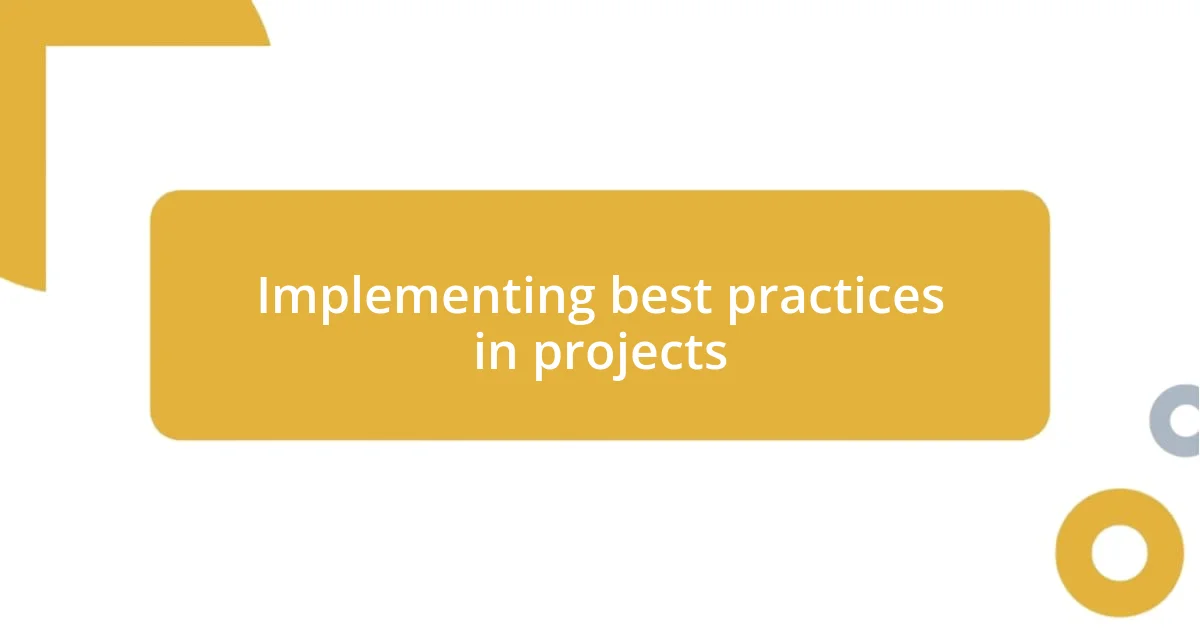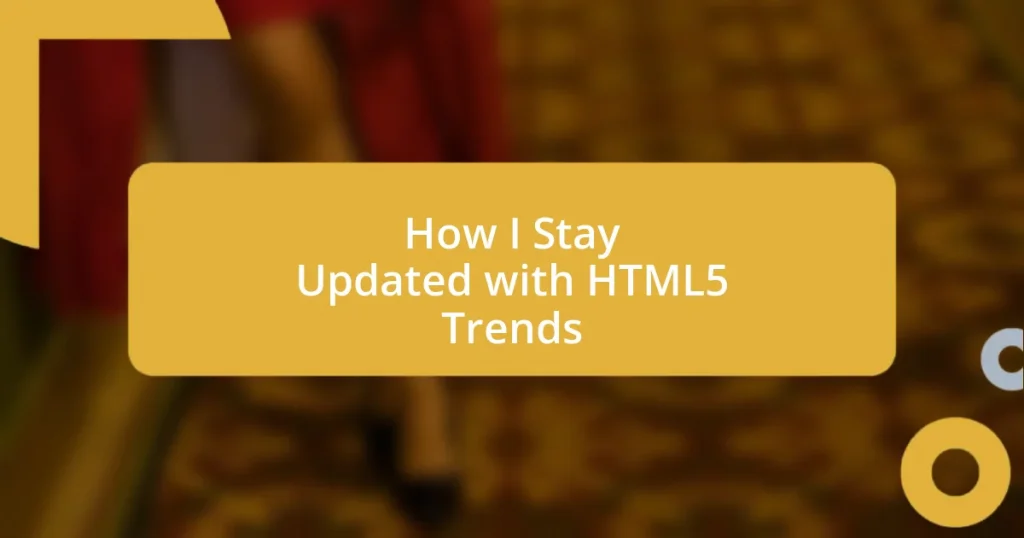Key takeaways:
- Understanding HTML5 fundamentals and semantic elements is crucial for effective web development, enhancing SEO and accessibility.
- Engaging with HTML5 communities and attending webinars fosters knowledge exchange, networking, and collaboration with fellow developers.
- Implementing best practices, such as responsive design and thorough project planning, significantly improves user experience and project quality.

Understanding HTML5 fundamentals
Understanding the fundamentals of HTML5 is like laying the foundation for a sturdy building. When I first started coding, I remember feeling overwhelmed by the sheer number of elements and attributes at my fingertips. Yet, I soon realized that mastering the basics—like understanding the structure of a document with tags such as <html>, <head>, and <body>—is crucial for creating effective web pages.
As I delved deeper into HTML5, I discovered its semantic elements, which, to me, felt like giving meaning to the content. Instead of just using generic <div> tags, utilizing elements like <header>, <footer>, and <article> made my code more intuitive. Have you ever thought about how clear communication is vital in any relationship? In the same way, semantic tags communicate the content’s purpose to browsers and developers, enhancing SEO and accessibility.
I often find myself reflecting on how the transition from HTML4 to HTML5 felt. It’s not just about new features like video support and the <canvas> element for drawing graphics; it’s also about the mindset shift. Embracing the philosophy behind HTML5—like prioritizing user experience and responsive design—truly transformed how I approach web development and motivated me to keep learning and adapting in this ever-evolving field.

Following reputable online resources
Staying updated with HTML5 trends requires real commitment, especially when it comes to finding the right online resources. I’ve learned the importance of following reputable websites that consistently provide reliable and cutting-edge information. Whether it’s tutorials, blog posts, or industry news, these platforms keep me grounded and informed about the latest developments in web technologies.
Here are my go-to resources that I trust:
- MDN Web Docs: A comprehensive resource for learning about HTML5 and web standards.
- W3Schools: Great for quick references and practical code examples.
- CSS-Tricks: Offers insightful articles and tips on HTML5-related topics.
- Smashing Magazine: Publishes in-depth pieces on web development and design.
- A List Apart: Focuses on web standards and best practices while promoting thoughtful content.
I find myself checking in with these sites daily; it feels like having a reliable chat with industry friends who share their insights and discoveries. Each visit brings fresh inspiration and keeps my enthusiasm for web development alive. The vibrant discussions and comments often lead to new perspectives I hadn’t considered before. It’s these communal experiences that make the learning journey enjoyable and connected.

Engaging with HTML5 communities
Engaging with HTML5 communities is a vital component of staying updated in this fast-evolving field. I’ve discovered that joining forums and discussion groups, such as Stack Overflow and Reddit, offers an unparalleled chance to learn from others’ experiences. There’s something refreshing about asking a question and getting different perspectives; it’s like a casual brainstorming session with friends. These interactions not only bolster my understanding but often lead to deeper connections with fellow developers who share the same interests and passions.
Participating in local meetups or online webinars has also enriched my journey. I remember attending a local coding event where various developers showcased their projects. Engaging in these gatherings gives me a firsthand look at innovative uses of HTML5. Plus, the conversations that follow—filled with excitement, challenges, and discoveries—remind me that we’re all part of a vibrant community. The friendships and professional connections I’ve built through these experiences have transformed my development path, providing both support and motivation.
Lastly, contributing to open-source projects has greatly enhanced my HTML5 skills while connecting me with like-minded individuals. I vividly recall my first contribution; it was both exhilarating and a bit nerve-wracking. But the feedback from project maintainers and collaborators ignited a spark in me. I felt like I was not just learning but actively participating in something larger than myself. This sense of belonging is incredibly motivating; it pushes me to keep pushing boundaries and embracing new challenges in web development.
| HTML5 Community Type | Benefits |
|---|---|
| Forums/Discussion Groups | Diverse Perspectives & Immediate Feedback |
| Meetups/Webinars | Networking & Real-World Learning |
| Open-Source Projects | Hands-on Experience & Collaboration |

Attending webinars and workshops
Attending webinars and workshops has become one of my favorite ways to stay at the forefront of HTML5 trends. Not long ago, I participated in a workshop led by an industry expert who shared unique insights into the latest HTML5 features. The hands-on exercises not only sharpened my skills but made the learning experience interactive and memorable. I often find myself thinking: how else would I have learned such practical applications if I hadn’t joined?
Webinars, in particular, are wonderful because they provide access to global leaders in web development. I remember one session where the presenter dissected real-world applications of HTML5 in immersive web design projects. As I listened, I felt a rush of inspiration—it was a reminder of how dynamic our field is and how important it is to keep exploring new ideas. The Q&A segment was my favorite part, where I could directly engage and ask questions that had been lingering in my mind.
Moreover, attending these events fosters a sense of community that’s hard to replicate elsewhere. After one workshop, I chatted with fellow participants over a virtual coffee. We exchanged contact information, and now we share resources and tips regularly. It’s beautiful how these connections blossom from simply being curious and eager to learn. When I look back, I realize it’s not just about acquiring knowledge; it’s about the friendships and networks that fuel my passion for HTML5.

Experimenting with new features
Experimenting with new features is where the real magic happens for me. I often carve out some time each week to play around with the latest HTML5 specifications, just to see how they work in practice. For instance, I vividly remember the first time I tried incorporating the Canvas element into my projects. I felt like a kid in a candy store, crafting visual elements with just a few lines of code. The joy of seeing my creations come to life was exhilarating. Isn’t it amazing how something that seems simple on the surface can unlock so much creativity?
I’ve found that setting up small personal projects is an excellent way to dive into experimentation. Last month, I built a simple game using the Audio and Video APIs, and believe me, there were moments of frustration when things didn’t work as expected. But each challenge pushed me to dig deeper into the documentation and explore how I could better shape my code. There’s a particular thrill in pushing boundaries and discovering what you can achieve. It’s like a mini-adventure each time; have you ever noticed how much you learn when things don’t go as planned?
Engagement through experimentation also allows me to share those discoveries with my peers. After figuring out a particularly nifty way to improve site performance with Web Workers, I presented my findings at a small workshop. The discussions that ensued were both enlightening and invigorating. I realized then that experimenting is not just about personal growth; it’s about contributing to the collective knowledge of our community. How rewarding is it to be part of a cycle where learning simply fuels more learning?

Subscribing to relevant newsletters
Subscribing to relevant newsletters has been a game-changer for me in staying informed about HTML5 trends. I recall stumbling upon a newsletter dedicated to cutting-edge web development topics. The first issue I received was packed with interviews from industry leaders and tips on leveraging new HTML5 features. I remember thinking, how did I ever manage without this resource? It felt like opening a treasure chest of knowledge right in my inbox.
Another aspect I cherish about newsletters is the curated content. They filter out the noise, presenting only what truly matters. I distinctly remember one edition that focused solely on accessibility features in HTML5. It was illuminating. This information sparked my curiosity to experiment with the aria-* attributes, enhancing my projects and ensuring they’re more user-friendly. How often does a newsletter prompt you to take action in your work?
Connecting with the community is another unexpected benefit of these subscriptions. I’ve interacted with fellow subscribers through comments and discussions sparked by newsletter content. One time, I reached out to someone after reading their take on HTML5 performance optimizations. This led to an engaging exchange of ideas and, before I knew it, we were collaborating on a mini-project that showcased our findings. Isn’t it fascinating how a simple email can lead to such enriching connections?

Implementing best practices in projects
When it comes to implementing best practices in my projects, I’ve learned that organization is key. I often create a checklist before diving into a new task, ensuring that I adhere to web standards and cross-browser compatibility. I remember a project where I skimped on these steps, thinking I could fix issues later. Spoiler alert: I spent more time troubleshooting than I would have if I had just taken a little extra care upfront. Have you ever found yourself wishing you had prioritized planning over patchwork fixes?
I also emphasize the importance of responsive design in my work. For instance, during a recent project for a local business, I made it a point to test the site on different devices as I went along. The moment I saw the layout seamlessly adapt to a smartphone was about as satisfying as the first sip of your favorite coffee in the morning. It’s those little victories that remind you how crucial best practices are in delivering a great user experience. How often do you take a step back to truly appreciate the ease with which users interact with your work?
Engaging in code reviews with my peers has been invaluable, too. I recall a time when a colleague spotted a minor oversight in my use of HTML5 semantic elements. I initially felt defensive, but accepting that feedback led to immense growth. It’s a humbling experience to realize that collaboration can shine a light on areas you might overlook. Have you ever thought about how a simple conversation can elevate the quality of your projects?















